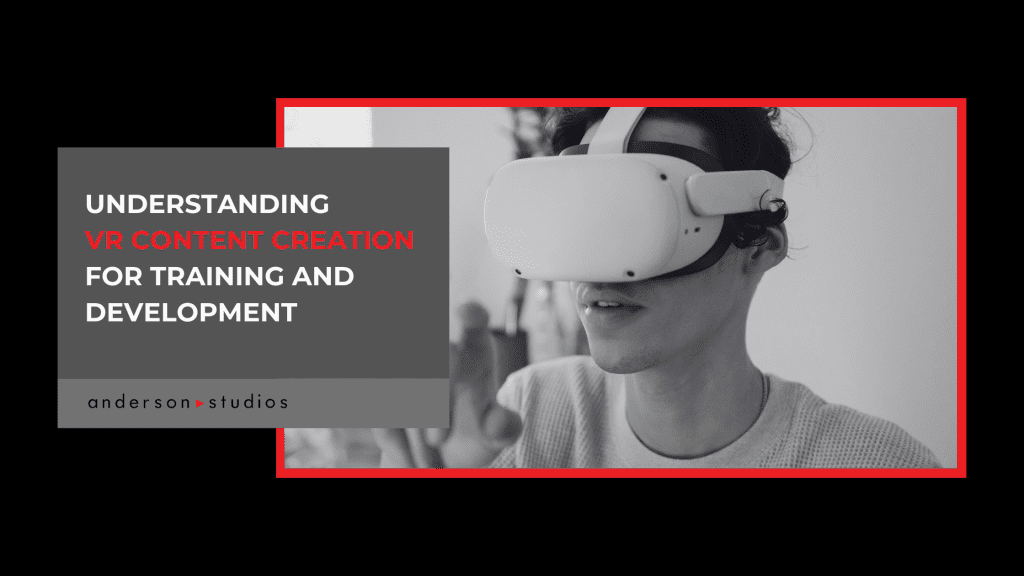
Virtual reality (VR) content creation is a revolutionary tool in training and development, offering immersive learning experiences that transcend traditional methods. As industries continue to evolve, the demand for effective training solutions becomes increasingly paramount.
VR has captivated imaginations with its ability to transport users to virtual environments, offering an unparalleled level of engagement and interactivity. Today, VR is not just a tool for entertainment but a powerful instrument for education and skill development.
Anderson Studios recognises the transformative potential of VR in this landscape and stands at the forefront of content creation for training and development.
Join us as we delve into the intricacies of VR and its profound impact on learning outcomes.
The Evolution of Training and Development
Training methodologies have undergone a remarkable evolution over the years, transitioning from traditional approaches to more immersive and interactive solutions. This evolution has been driven by advancements in technology, changing learner preferences, and the growing demand for effective skill development in a rapidly evolving world.
In the past, training often relied on conventional methods such as classroom lectures, textbooks, and practical demonstrations. While these approaches provided valuable information, they often lacked the engagement and retention necessary for effective learning. Learners were passive recipients of knowledge, with limited opportunities for hands-on experience.
VR, on the other hand, enables users to immerse themselves in realistic environments, where they can interact with objects, simulate real-world scenarios, and receive instant feedback. This level of immersion not only enhances engagement but also facilitates deeper learning and skill acquisition.
The Benefits of Virtual Reality in Instructional Design
One of the key advantages of VR-based training is its ability to provide learners with experiential learning opportunities in a safe and controlled environment. For industries such as oil and gas, manufacturing, and aviation, VR simulations offer a risk-free way to practice complex procedures and protocols, thereby reducing the potential for errors and accidents.
VR training is inherently scalable and flexible, allowing organisations to train employees remotely and efficiently. With VR, geographical barriers are no longer a limitation, as learners can access training modules from anywhere in the world, at any time. This flexibility not only improves accessibility but also reduces training costs and logistical challenges.
Key Considerations in VR Content Creation
Creating effective VR content for training and development requires careful consideration of various factors to ensure the delivery of immersive and impactful learning experiences.
Understanding the Target Audience and Learning Objectives
- Identifying the specific needs and preferences of the target audience is essential for tailoring VR content to their learning goals.
- Conducting thorough audience analysis helps in designing experiences that resonate with learners, leading to higher engagement and retention.
- Clearly defining learning objectives ensures that VR content aligns with organisational training goals and focuses on imparting relevant skills and knowledge.
Designing Interactive and Engaging VR Environments
- Immersive VR environments should be designed with interactivity in mind, allowing learners to actively engage with the content and manipulate objects.
- Incorporating gamification elements such as challenges, rewards, and simulations enhances engagement and motivation, making learning more enjoyable.
- Interactive scenarios and branching narratives enable learners to make decisions and witness the consequences of their actions, facilitating experiential learning.
Ensuring Accessibility and Inclusivity in VR Experiences
- Accessibility features such as adjustable text size, colour contrast options, and audio descriptions should be integrated into VR content to accommodate learners with diverse needs.
- Designing intuitive user interfaces and navigation systems enhances usability and ensures that learners can easily navigate through the VR environment.
- Considering cultural sensitivities and avoiding stereotypes in VR content promotes inclusivity and fosters a welcoming learning environment for all users.
Work with Anderson Studios to Create Immersive Training Videos
Partnering with Anderson Studios offers organisations the opportunity to harness the power of VR in creating immersive and impactful training content. With a proven track record of excellence in video production, animation, motion graphics, and instructional design, Anderson Studios is uniquely positioned to bring your vision to life in the virtual world.
Anderson Studios stays abreast of the latest advancements in VR technology, leveraging cutting-edge tools and techniques to create immersive and visually stunning content.
Our team of experienced professionals combines technical expertise with creative flair to push the boundaries of what is possible in VR content creation, delivering experiences that captivate and inspire learners.
We have partnered with leaders in the industry to bring immersive learning experiences to people in high-risk sectors in Africa. Our strategic partnership with Facilitate makes experiential training simple on a large scale. Additionally, we make use of 3DVista Software to create three-dimensional assets that further expand upon the learning experience.
From realistic simulations to interactive learning environments, Anderson Studios harnesses the full potential of VR to create training solutions that drive real-world results.
Get in Touch
Contact us today to learn more about how Anderson Studios can help elevate your training and development initiatives through the power of VR.

